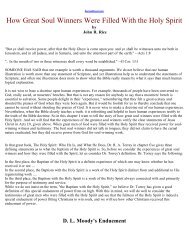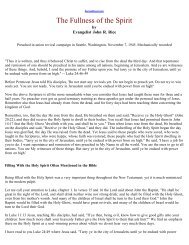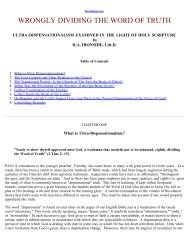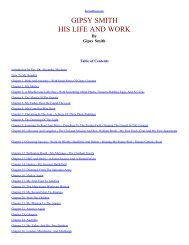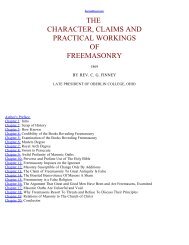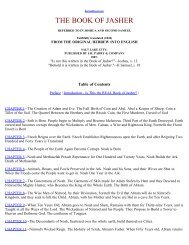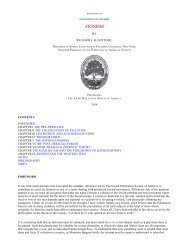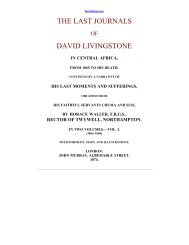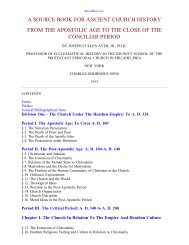Legends of Babylon and Egypt in Relation to Hebrew Tradition.pdf
Legends of Babylon and Egypt in Relation to Hebrew Tradition.pdf
Legends of Babylon and Egypt in Relation to Hebrew Tradition.pdf
You also want an ePaper? Increase the reach of your titles
YUMPU automatically turns print PDFs into web optimized ePapers that Google loves.
may yet be accepted <strong>in</strong> a modified form. In com<strong>in</strong>g <strong>to</strong> his conclusion he may have been <strong>in</strong>fluenced by what seems <strong>to</strong><br />
me an undoubted correspondence between one <strong>of</strong> the rulers <strong>in</strong> our list <strong>and</strong> the sixth Antediluvian k<strong>in</strong>g <strong>of</strong> Berossus. I<br />
th<strong>in</strong>k few will be disposed <strong>to</strong> dispute the equation<br />
{Daonos poimon} = Etana, a shepherd.<br />
Each list preserves the hero's shepherd orig<strong>in</strong> <strong>and</strong> the correspondence <strong>of</strong> the names is very close, Daonos merely<br />
transpos<strong>in</strong>g the <strong>in</strong>itial vowel <strong>of</strong> Etana.[2] That Berossus should have translated a Post- diluvian ruler <strong>in</strong><strong>to</strong> the<br />
Antediluvian dynasty would not be at all surpris<strong>in</strong>g <strong>in</strong> view <strong>of</strong> the absence <strong>of</strong> detailed correspondence between his later<br />
dynasties <strong>and</strong> those we know actually occupied the <strong>Babylon</strong>ian throne. Moreover, the <strong>in</strong>clusion <strong>of</strong> <strong>Babylon</strong> <strong>in</strong> his list<br />
<strong>of</strong> Antediluvian cities should make us hesitate <strong>to</strong> regard all the rulers he assigns <strong>to</strong> his earliest dynasty as necessarily<br />
reta<strong>in</strong><strong>in</strong>g <strong>in</strong> his list their orig<strong>in</strong>al order <strong>in</strong> Sumerian tradition. Thus we may with a clear conscience seek equations<br />
between the names <strong>of</strong> Berossus' Antediluvian rulers <strong>and</strong> those preserved <strong>in</strong> the early part <strong>of</strong> our Dynastic List, although<br />
we may regard the latter as equally Post-diluvian <strong>in</strong> Sumerian belief.<br />
[1] See the brief statement he makes <strong>in</strong> the course <strong>of</strong> a review <strong>of</strong> Dr. Poebel's volumes <strong>in</strong> the /American Journal <strong>of</strong><br />
Semitic Languages <strong>and</strong> Literature/, XXXI, April 1915, p. 225. He does not compare any <strong>of</strong> the names, but he promises<br />
a study <strong>of</strong> those preserved <strong>and</strong> a comparison <strong>of</strong> the list with Berossus <strong>and</strong> with Gen. iv <strong>and</strong> v. It is possible that<br />
Pr<strong>of</strong>essor Bar<strong>to</strong>n has already fulfilled his promise <strong>of</strong> further discussion, perhaps <strong>in</strong> his /Archaeology <strong>and</strong> the Bible/, <strong>to</strong><br />
the publication <strong>of</strong> which I have seen a reference <strong>in</strong> another connexion (cf. /Journ. Amer. Or. Soc., Vol. XXXVI, p.<br />
291); but I have not yet been able <strong>to</strong> obta<strong>in</strong> sight <strong>of</strong> a copy.<br />
[2] The variant form {Daos} is evidently a mere contraction, <strong>and</strong> any claim it may have had <strong>to</strong> represent more closely<br />
the orig<strong>in</strong>al form <strong>of</strong> the name is <strong>to</strong> be disregarded <strong>in</strong> view <strong>of</strong> our new equation.<br />
This reflection, <strong>and</strong> the result already obta<strong>in</strong>ed, encourage us <strong>to</strong> accept the follow<strong>in</strong>g further equation, which is yielded<br />
by a renewed scrut<strong>in</strong>y <strong>of</strong> the lists:<br />
{'Ammenon} = Enmenunna.<br />
Here Ammenon, the fourth <strong>of</strong> Berossus' Antediluvian k<strong>in</strong>gs, presents a wonderfully close transcription <strong>of</strong> the Sumerian<br />
name. The /n/ <strong>of</strong> the first syllable has been assimilated <strong>to</strong> the follow<strong>in</strong>g consonant <strong>in</strong> accordance with a recognized law<br />
<strong>of</strong> euphony, <strong>and</strong> the resultant doubl<strong>in</strong>g <strong>of</strong> the /m/ is faithfully preserved <strong>in</strong> the Greek. Precisely the same <strong>in</strong>itial<br />
component, /Enme/, occurs <strong>in</strong> the name Enmeduranki, borne by a mythical k<strong>in</strong>g <strong>of</strong> Sippar, who has long been<br />
recognized as the orig<strong>in</strong>al <strong>of</strong> Berossus' seventh Antediluvian k<strong>in</strong>g, {Euedorakhos}.[1] There <strong>to</strong>o the orig<strong>in</strong>al /n/ has<br />
been assimilated, but the Greek form reta<strong>in</strong>s no doubl<strong>in</strong>g <strong>of</strong> the /m/ <strong>and</strong> po<strong>in</strong>ts <strong>to</strong> its further weaken<strong>in</strong>g.<br />
[1] Var. {Euedoreskhos}; the second half <strong>of</strong> the orig<strong>in</strong>al name, Enmeduranki, is more closely preserved <strong>in</strong><br />
/Edoranchus/, the form given by the Armenian transla<strong>to</strong>r <strong>of</strong> Eusebius.<br />
I do not propose <strong>to</strong> deta<strong>in</strong> you with a detailed discussion <strong>of</strong> Sumerian royal names <strong>and</strong> their possible Greek<br />
equivalents. I will merely po<strong>in</strong>t out that the two suggested equations, which I venture <strong>to</strong> th<strong>in</strong>k we may regard as<br />
established, throw the study <strong>of</strong> Berossus' mythological personages upon a new plane. No equivalent has hither<strong>to</strong> been<br />
suggested for {Daonos}; but {'Ammenon} has been confidently expla<strong>in</strong>ed as the equivalent <strong>of</strong> a conjectured<br />
<strong>Babylon</strong>ian orig<strong>in</strong>al, Ummânu, lit. "Workman". The fact that we should now have recovered the Sumerian orig<strong>in</strong>al <strong>of</strong><br />
the name, which proves <strong>to</strong> have no connexion <strong>in</strong> form or mean<strong>in</strong>g with the previously suggested Semitic equivalent,<br />
tends <strong>to</strong> cast doubt on other Semitic equations proposed. Perhaps {'Amelon} or {'Amillaros} may after all not prove <strong>to</strong><br />
be the equivalent <strong>of</strong> Amêlu, "Man", nor {'Amemps<strong>in</strong>os} that <strong>of</strong> Amêl-S<strong>in</strong>. Both may f<strong>in</strong>d their true equivalents <strong>in</strong><br />
some <strong>of</strong> the miss<strong>in</strong>g royal names at the head <strong>of</strong> the Sumerian Dynastic List. There <strong>to</strong>o we may provisionally seek<br />
{'Aloros}, the "first k<strong>in</strong>g", whose equation with Aruru, the <strong>Babylon</strong>ian mother- goddess, never appeared a very happy<br />
suggestion.[1] The <strong>in</strong>genious proposal,[2] on the other h<strong>and</strong>, that his successor, {'Alaparos}, represents a miscopied<br />
{'Adaparos}, a Greek render<strong>in</strong>g <strong>of</strong> the name <strong>of</strong> Adapa, may still hold good <strong>in</strong> view <strong>of</strong> Etana's presence <strong>in</strong> the Sumerian<br />
dynastic record. Ut-napishtim's title, Khasisatra or Atrakhasis, "the Very Wise", still <strong>of</strong> course rema<strong>in</strong>s the established<br />
equivalent <strong>of</strong> {Xisouthros}; but for {'Otiartes} (? {'Opartes}), a rival <strong>to</strong> Ubar- Tutu, Ut-napishtim's father, may<br />
perhaps appear. The new identifications do not <strong>of</strong> course dispose <strong>of</strong> the old ones, except <strong>in</strong> the case <strong>of</strong> Ummânu; but



